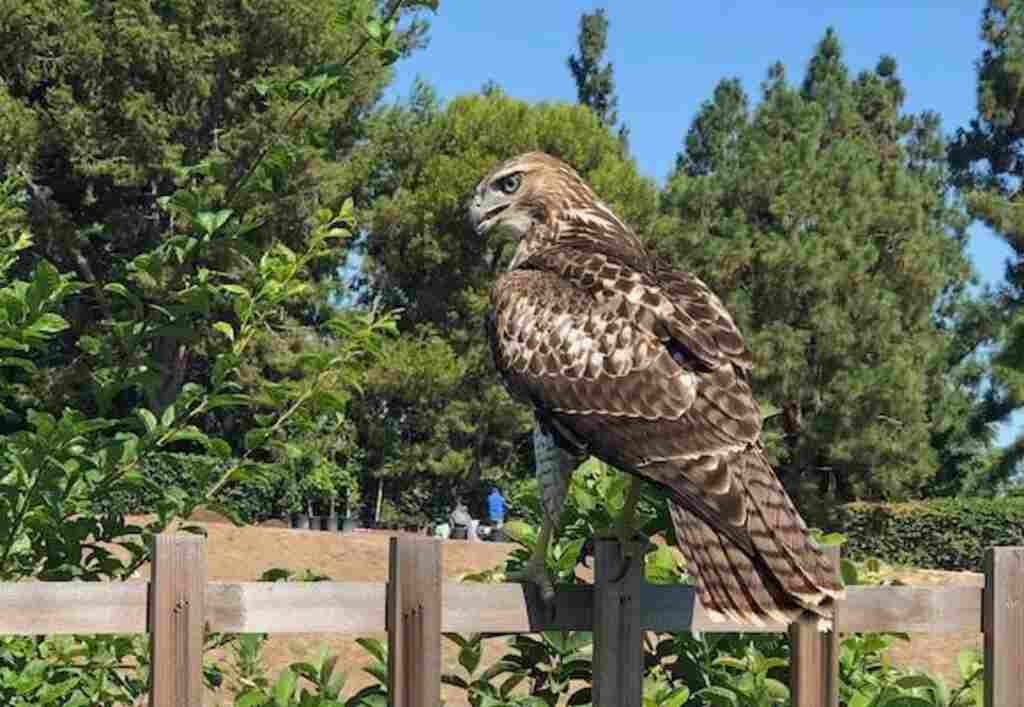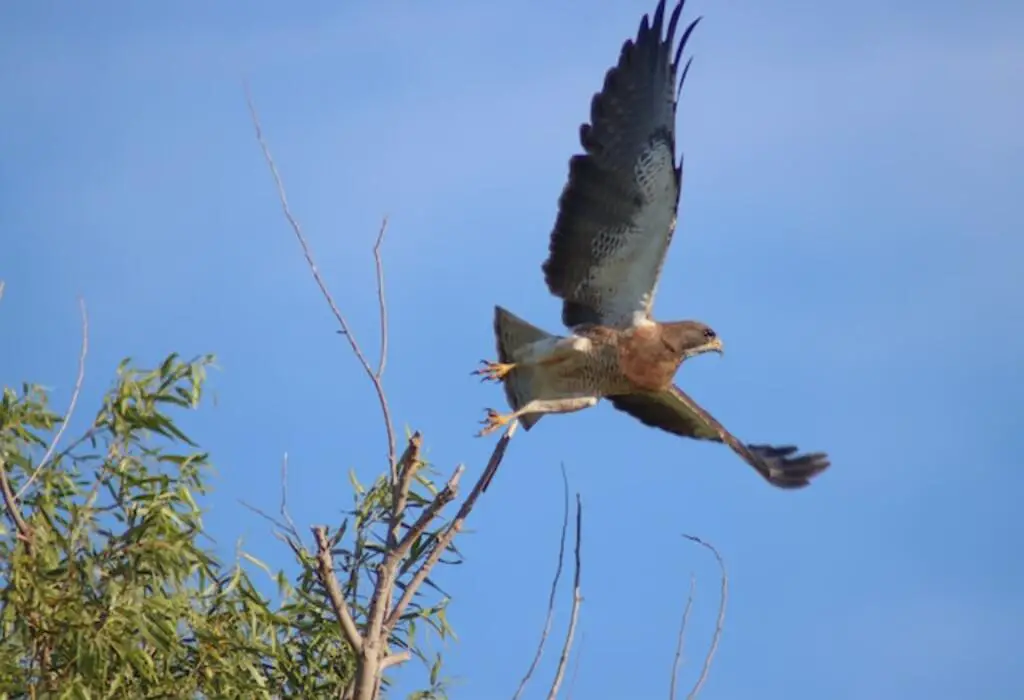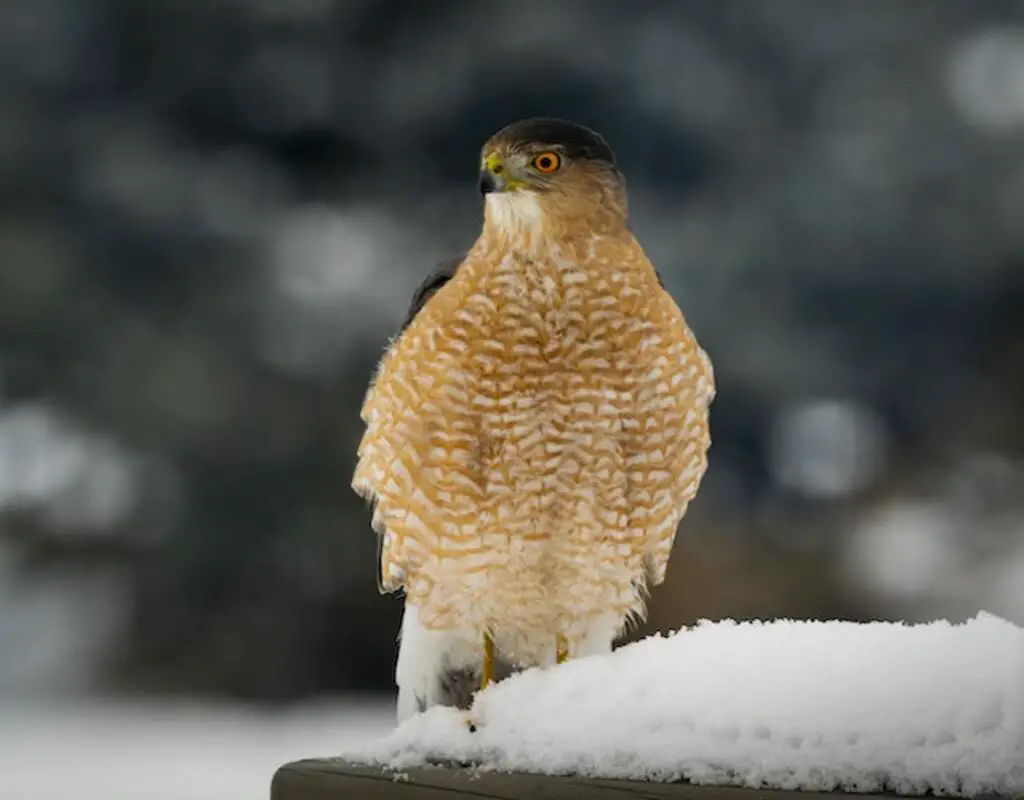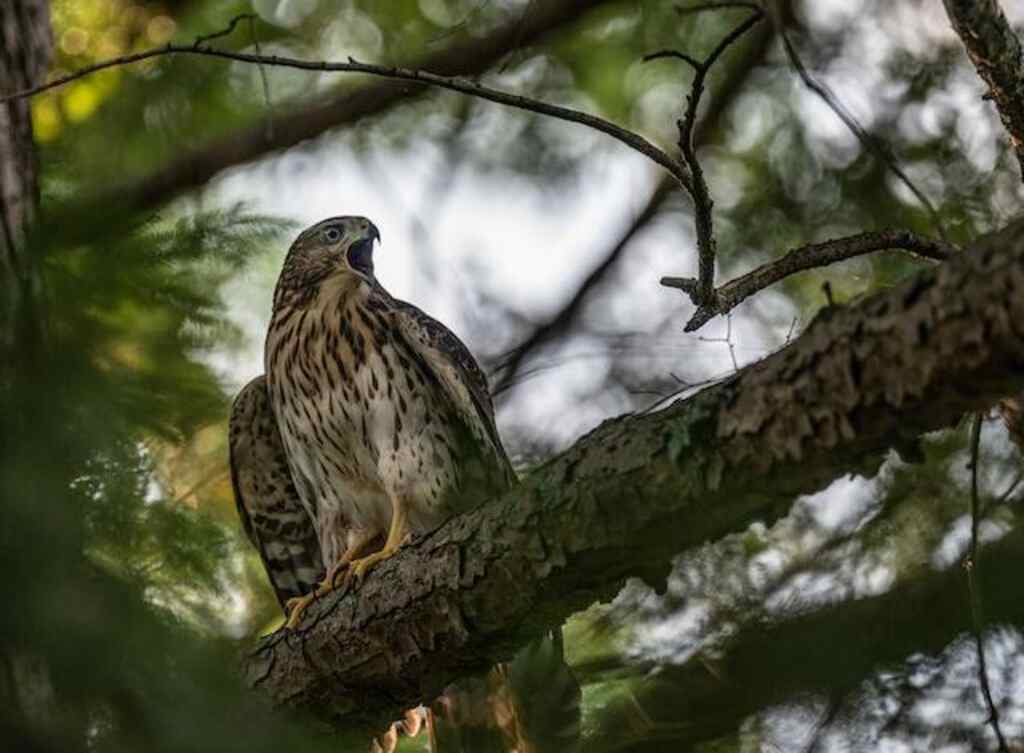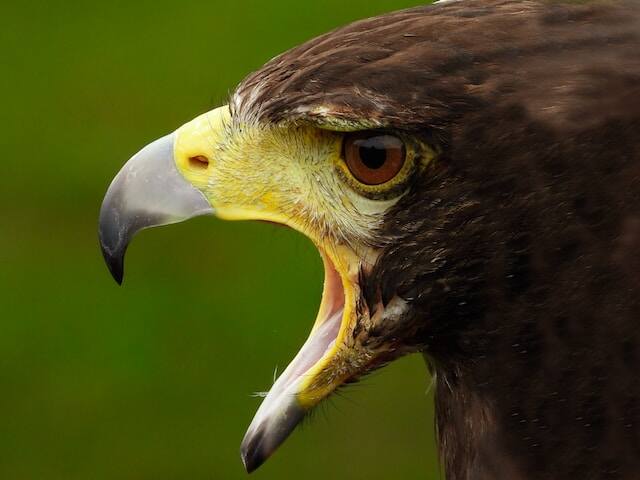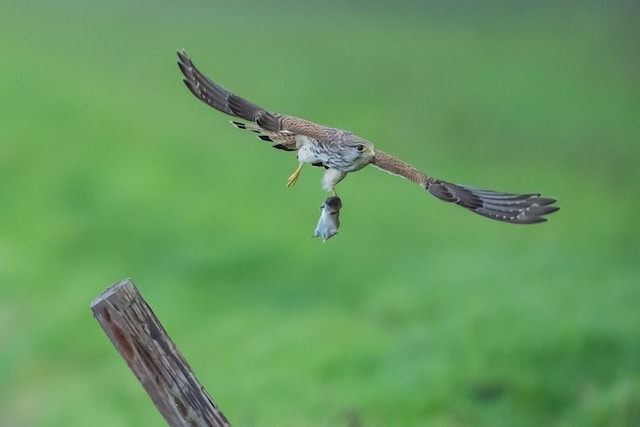Hawks can be found in many regions of the world, including North America, Europe, Africa, and Asia. These birds of prey are known for their sharp talons and keen eyesight, which help them hunt for food.
The diet of hawks varies depending on the species and geographic location. Some hawks primarily eat rodents, while others hunt birds or insects.
Table of Contents
- 1 Types of Hawks
- 2 Hawk Diet
- 3 Hawk Hunting Behavior
- 4 Cat predation by hawks
- 5 Rare Occurrences and Precautions
- 6 Conclusion
- 7 FAQs: Do Hawks Eat Cats?
- 7.1 Do hawks pose a threat to cats?
- 7.2 Are all cat breeds equally at risk from hawks?
- 7.3 How can I protect my cat from hawks?
- 7.4 Are hawks a common threat in urban areas?
- 7.5 Can a hawk carry off a fully grown cat?
- 7.6 Are there specific hawk species known for targeting cats?
- 7.7 Should I report hawk attacks on cats?
- 7.8 Can outdoor cat enclosures protect against hawk attacks?
- 7.9 Are there any visual cues that may deter hawks from approaching?
- 7.10 Can I train my cat to avoid hawk attacks?
- 8 Author
A Brief Overview of Hawks and Their Diet
Hawks are carnivorous predators that feed on a variety of animals. They belong to the family Accipitridae, which also includes eagles, kites, and harriers. The size and coloration of hawks vary depending on the species.
For instance, the Cooper’s hawk is a medium-sized bird that ranges in length from 14 to 20 inches (36-51 cm), while the red-tailed hawk is a large bird that can range from 18 to 25 inches (46-64 cm) in length.
The diet of hawks generally consists of small animals such as rodents and smaller birds.
However, some species may also eat insects or reptiles. Hawks typically hunt by perching on a high vantage point such as a tree branch or telephone pole before swooping down to catch their prey with their sharp talons.
The Question: Do Hawks Eat Cats?
One question that often arises among pet owners is whether hawks pose a threat to their cats. While it is uncommon for hawks to attack domestic pets like cats or dogs, there have been reported incidents where this has occurred.
Some species of hawks are more likely than others to prey on small animals like cats.
For example, red-tailed hawks have been known to attack cats occasionally when hunting for food in suburban areas, where they may not have access to their typical prey like rabbits or squirrels.
Hawks are fascinating birds of prey known for their sharp talons and keen eyesight.
Their diets consist primarily of small animals, but some species may eat insects or reptiles as well.
While it is not common for hawks to attack domestic pets like cats, pet owners should still take precautions to protect their furry friends around these birds of prey.
Types of Hawks
Hawks are classified into two main categories: accipiters and buteos. Accipiters are small to medium-sized hawks that have long tails and short wings, which allow them to maneuver through dense foliage while hunting.
Buteos, on the other hand, are larger hawks with broad wings and shorter tails.
They prefer open habitats such as prairies or deserts where they can soar high in the sky looking for prey. Within these two categories, there are different species of hawks that vary in size, appearance, and diet.
Some common types of accipiters include the sharp-shinned hawk (Accipiter striatus), Cooper’s hawk (A. cooperii), and the northern goshawk (A. gentilis).
These birds are known for their agility and speed when hunting smaller prey like songbirds.
Buteos also have several species that fall under this category, including the red-tailed hawk (Buteo jamaicensis), Swainson’s hawk (B. swainsoni), and rough-legged hawk (B. lagopus).
These hawks typically feed on a variety of small mammals such as rabbits, squirrels, voles, mice as well as birds.
Overview of Different Types of Hawks
Some species like the red-shouldered hawks (Accipiter striatus) have distinctive reddish-brown feathers on their wings, while others like the rough-legged hawks have feathered legs that keep them warm during colder months.
Harris’s Hawks (Parabuteo unicinctus) is a unique type of buteo found in Arizona which hunts in groups rather than alone or with one mate like most other birds do.
Some birds occasionally migrate during certain seasons; others remain relatively dormant throughout all seasons or only move short distances depending on food availability or breeding habitats.
Which Types are Known to Prey on Small Animals, including Cats
Accipiters are known for their agility and speed while hunting small prey like songbirds. They are also known to hunt small mammals like rabbits, mice, and squirrels.
The sharp-shinned hawk is a small accipiter that is known for its quick movements and ability to hunt in dense areas. Cooper’s hawks are larger than sharp-shinned hawks but have similar hunting techniques.
Buteos generally feed on a variety of small mammals such as rabbits, squirrels, voles, mice as well as birds.
However, some species within the buteo category such as the red-tailed hawk have been observed preying on cats.
It’s important to note that while some hawks may occasionally prey on cats or other domestic animals, it is not very common and most hawk species do not pose a significant threat to pets.
In general, hawks tend to avoid urban areas where pets are more likely to be found due to lack of prime hunting grounds.
Hawk Diet
Hawks are birds of prey that belong to the family Accipitridae. They are known for their sharp talons and hooked beaks that they use to hunt and kill their prey.
As predators, hawks have a diverse diet that varies depending on the species, geographic location, and time of year.
However, their primary food source is small animals such as rodents, insects, reptiles, amphibians, and other birds.
What Hawks Typically Eat
Most hawks feed on small animals such as mice, voles, shrews, rabbits, squirrels, and other rodents. They also eat snakes and lizards, as well as larger birds like doves or pigeons.
Some species of hawks have been observed eating fish or even carrion when other food sources are scarce.
The Red-tailed hawk is one of the most common species in North America and feeds primarily on small mammals like mice and rabbits.
The Cooper’s hawk is another species that frequently preys on small mammals but will also eat birds such as robins or jays.
How Their Diet Varies Depending On The Species
Different species of hawks have adapted to hunting different types of prey based on their size and physical characteristics.
For example, the Sharp-shinned hawk has long legs suited for chasing down smaller birds like sparrows or finches, while the larger Northern goshawk hunts larger prey like rabbits or squirrels.
In addition to differences in size and physical characteristics between different species of hawks, diet can also vary depending on geographic location and seasonality.
For example, some hawks migrate from colder climates during the winter months, which can change their available food supply.
Overall, though, it’s important to understand that while some species may prefer certain types of prey over others, they are all opportunistic hunters with a variety in what they eat.
Understanding the various factors that can influence a hawk’s dietary patterns is key to understanding whether or not hawks are a threat to house pets like cats.
Hawk Hunting Behavior
Hawks are one of the most skilled predators in the animal kingdom. They have evolved to be highly efficient hunters, with their sharp talons and powerful beaks that allow them to capture prey in a matter of seconds. The way hawks hunt for prey is both fascinating and intimidating.
Description of How Hawks Hunt for Prey
Hawks use a variety of hunting techniques depending on the species and the type of prey they are targeting.
One common tactic is to soar high above their hunting grounds, scanning the landscape below for any signs of movement.
Once they spot a potential target, they will dive toward it at tremendous speeds, often exceeding 100 miles per hour.
Another hunting technique used by hawks is called “still-hunting.” This involves perching on a high vantage point and waiting for unsuspecting prey to come within striking distance.
Once the hawk spots its target, it will launch itself off its perch and swoop down on its chosen victim.
How They Select Their Targets
When selecting their targets, hawks take into account a variety of factors, including size, agility, and behavior patterns.
Small animals such as rodents or birds are particularly vulnerable to hawk attacks because they are easier to catch and kill than larger animals such as deer or coyotes.
In general, hawks prefer to hunt during daylight hours, when visibility is good, and they can see their targets more clearly.
They also tend to hunt in open areas where there is plenty of space for them to maneuver in flight.
Despite their impressive hunting skills, hawks do not always succeed in catching their intended prey. Factors such as weather conditions or an animal’s ability to sense danger can make it difficult for hawks to make successful kills.
Overall, understanding how hawks hunt for prey can help pet owners better protect their cats from potential attacks by these formidable predators.
By taking precautions such as keeping cats indoors during daylight hours and providing them with ample hiding places outside, owners can help reduce their pets’ risk of falling prey to hawks or other birds of prey.
Cat predation by hawks
Hawks, like other birds of prey, are known for their hunting prowess. They have sharp talons and beaks that make them effective hunters.
While small rodents and birds are their primary prey, there is evidence that some hawk species do occasionally prey on domestic cats.
While cat predation by hawks is relatively rare, it’s important for pet owners to understand the risks and take precautions to protect their pets.
Some hawk species, such as the Cooper’s Hawk and the Sharp-shinned Hawk, are more likely to hunt in residential areas where cats may be present.
Evidence that some hawk species do occasionally prey on cats
There have been documented cases of hawks attacking and killing domestic cats. In one study conducted in California, researchers found that out of 687 reported incidents of raptor attacks on pets between 1993-2002, 36% involved attacks on cats.
Of those attacks involving cats, 23% were attributed to Cooper’s Hawks. However, it’s important to note that these incidents are still relatively rare compared to the number of outdoor domestic cats in suburban areas.
Factors that contribute to cat predation by hawks
Several factors can increase the likelihood of a hawk attacking a cat. One factor is the size and behavior of the cat – smaller or more timid cats may be seen as easier targets by hawks.
A cat’s coat color can also make it more visible or less visible against different types of backgrounds – making them either easier or harder for a hawk to spot during flights over urban or suburban areas.
The amount of cover available for a potential prey animal can also determine whether a hawk will choose to attack it; without enough cover around where pets roam outdoors (bushes or trees) they will be seen more easily from above, which would give the raptor an opportunity to attack.
The behavior of the cat’s owner and the surrounding environment can also play a role – for example, if the owner feeds wildlife or provides nesting sites for hawks near their home.
Ultimately, while cat predation by hawks is a risk, it’s important to remember that these birds are a crucial part of our ecosystem and keep rodent populations in check.
Pet owners can take steps to reduce the likelihood of an attack by keeping cats indoors or supervised while outside, providing plenty of hiding places and cover in outdoor spaces, and being mindful of feeding wildlife that may attract hawks.
Rare Occurrences and Precautions
Discussion of How Rare it is for a Hawk to Attack a Cat
While hawks are known to prey on small animals, including rodents, squirrels, and rabbits, attacks on domestic cats are relatively rare.
This is because most hawk species do not view cats as prey items due to their size and agility. However, there have been documented cases of hawks attacking cats, especially in urban areas where natural prey may be scarce.
Hawk attacks on cats are most likely to occur during the nesting season, when hawks are busy feeding their young and are more aggressive in securing food sources.
Additionally, sick or injured cats may be more vulnerable targets for hawks.
It’s important to note that the majority of hawk attacks on cats result in non-fatal injuries, such as scratches or puncture wounds from talons.
However, severe injuries or death can occur if the hawk succeeds in carrying the cat away.
Precautions Pet Owners Can Take to Protect Their Cats from Hawk Attacks
While it’s impossible to completely eliminate the risk of a hawk attack on your cat, there are steps you can take to reduce the likelihood of an attack occurring:
1. Keep your cat indoors – The easiest way to prevent a hawk attack is by keeping your cat inside at all times. This may not be possible for outdoor cats who enjoy spending time outside, but limiting outdoor time during peak hunting hours (dawn and dusk) can help reduce the risk.
2. Create a safe outdoor space – If you have an outdoor cat, consider creating an enclosed area where they can roam safely without being exposed to predators like hawks. This could be as simple as building a fence around your yard or investing in a secure outdoor enclosure.
3. Make noise – Hawks are less likely to attack if they feel threatened or disturbed. Making noise, such as clapping your hands or using a whistle, can deter hawks from approaching your cat.
4. Keep an eye on your cat – If you do let your cat outside, it’s important to supervise them and keep an eye out for any signs of danger. If you see a hawk circling overhead or notice any other potential threats, bring your cat inside immediately.
Taking these precautions can help reduce the risk of a hawk attack on your beloved feline friend. Don’t let the fear of hawk attacks prevent you from enjoying the company of an outdoor cat, but always prioritize their safety and well-being above all else.
Conclusion
After exploring the topic of whether hawks eat cats, it is clear that while it is possible for some hawk species to prey on cats, it is not a common occurrence. Hawks typically feed on small mammals, birds and reptiles that are easier to capture and consume.
It’s important to understand the behavior and habits of hawks so that pet owners can ensure their feline friends are safe from potential attacks.
While rare, it’s still a good idea to take precautions, such as keeping cats indoors during times when hawks are most active.
Summary of Key Points Discussed in the Article
Throughout this article, we’ve explored the following key points: – Hawks typically feed on small mammals, birds and reptiles
– Some species of hawks have been known to prey on cats – Factors such as territory, prey availability and hunger level can contribute to hawk attacks on cats
– Precautions pet owners can take include keeping their pets indoors during times when hawks are most active
By understanding these points, pet owners can take steps to protect their beloved felines from potential hawk attacks.
Final Thoughts and Recommendations for Readers Concerned About the Safety of Their Pets Around Birds of Prey
While it’s understandable for pet owners to be concerned about their pets’ safety around birds of prey such as hawks, it’s important to remember that these incidents are rare.
Nonetheless, taking precautions such as keeping pets indoors during peak hunting hours can go a long way in ensuring their safety.
It’s also important for readers to educate themselves about local wildlife in their area so they know what threats may exist.
By staying informed and taking appropriate actions, pet owners can enjoy peace of mind knowing their furry friends are protected from potential harm.
While there is a possibility that hawks may occasionally prey on cats, taking precautions and staying informed can go a long way in ensuring the safety of our beloved pets.
FAQs: Do Hawks Eat Cats?
Do hawks pose a threat to cats?
Yes, hawks can pose a threat to cats, particularly small or vulnerable ones that are left unsupervised outdoors. Hawks are skilled predators and may target cats as potential prey if given the opportunity.
Are all cat breeds equally at risk from hawks?
While all cats can potentially be targeted by hawks, smaller cat breeds or kittens are more susceptible due to their size. Larger cat breeds may have a better chance of defending themselves against a hawk attack.
How can I protect my cat from hawks?
To protect your cat from hawks, it is best to keep them indoors or supervise them when outdoors. Creating a cat-friendly enclosed area in your yard, using deterrents like noise or visual distractions, and removing potential perching spots for hawks can also be helpful.
Are hawks a common threat in urban areas?
Hawks are adaptable and can be found in both urban and rural areas. While the frequency of hawk attacks on cats may vary depending on the location, it is important to be cautious regardless of the setting.
Can a hawk carry off a fully grown cat?
Most hawks cannot carry off a fully grown, healthy adult cat due to their size and weight. However, smaller hawks or injured cats may be more vulnerable to being lifted by a hawk.
Are there specific hawk species known for targeting cats?
Various hawk species, such as Cooper’s hawks and sharp-shinned hawks, have been observed targeting cats. These species are agile and have the ability to navigate through residential areas in pursuit of prey.
Should I report hawk attacks on cats?
It is beneficial to report hawk attacks on cats to local wildlife authorities or organizations involved in bird conservation. They can provide advice and information on managing potential conflicts between hawks and pets.
Can outdoor cat enclosures protect against hawk attacks?
Yes, outdoor cat enclosures or catteries can provide a safe space for cats to enjoy the outdoors while protecting them from potential hawk attacks. These enclosures typically have roofs or netting to prevent hawks from reaching the cats.
Are there any visual cues that may deter hawks from approaching?
Hawks can be deterred by visual cues such as reflective materials, hanging shiny objects, or placing scarecrow-like figures in the area. These measures may help discourage hawks from targeting your cat.
Can I train my cat to avoid hawk attacks?
Training cats to be cautious around potential threats like hawks is challenging, as cats have an instinctual drive to explore their surroundings. However, teaching your cat recall commands and supervising outdoor activities can reduce the risk of hawk encounters.

